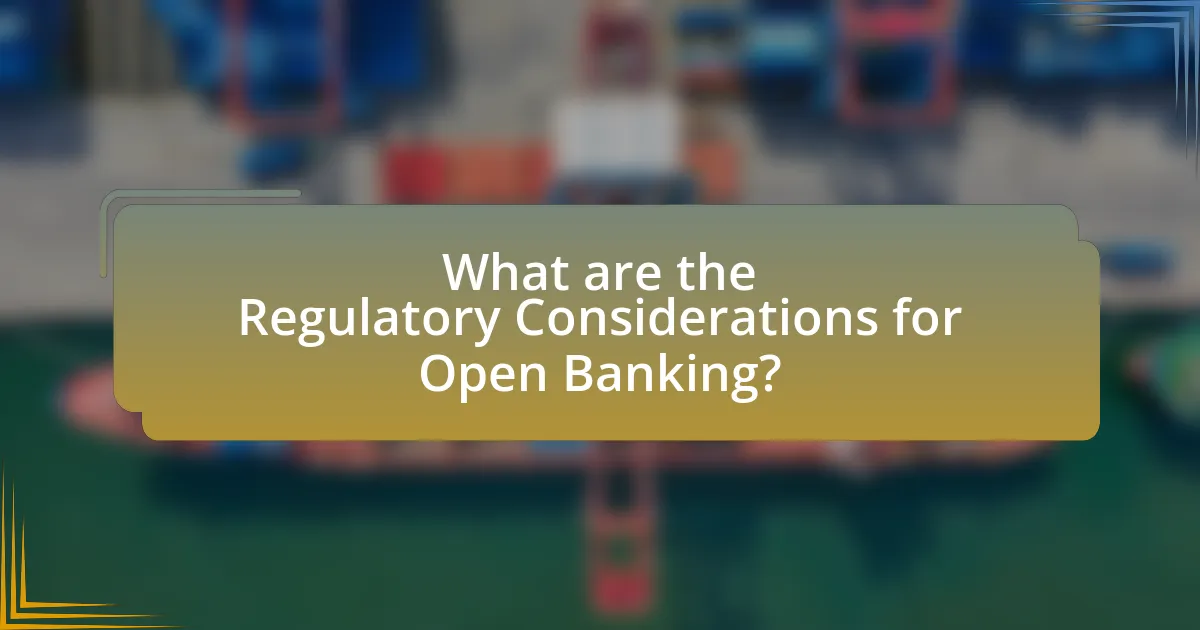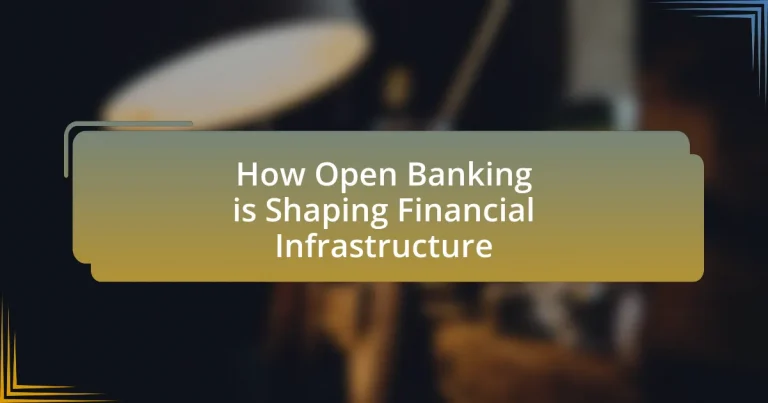Open Banking is a financial services model that enables third-party developers to access consumer banking data through application programming interfaces (APIs), significantly transforming financial infrastructure. This article explores the role of Open Banking in enhancing competition, innovation, and consumer choice within the banking sector, as mandated by regulations such as the European Union’s Revised Payment Services Directive (PSD2). Key components of Open Banking, including APIs, customer consent, and regulatory frameworks, are examined, along with the benefits it offers, such as improved customer experiences and cost savings for institutions. Additionally, the article addresses the challenges banks face in implementing Open Banking and the future trends that may shape its evolution in the coming decade.

What is Open Banking and its Role in Financial Infrastructure?
Open Banking is a financial services model that allows third-party developers to access consumer banking data through application programming interfaces (APIs). This model enhances financial infrastructure by promoting competition, innovation, and consumer choice in banking services. For instance, Open Banking enables fintech companies to create new financial products and services that can better meet consumer needs, leading to improved customer experiences and potentially lower costs. According to the European Union’s Revised Payment Services Directive (PSD2), which mandates Open Banking practices, this approach has been shown to increase market efficiency and foster innovation in the financial sector.
How does Open Banking function within the financial ecosystem?
Open Banking functions within the financial ecosystem by enabling third-party providers to access bank customers’ financial data through secure application programming interfaces (APIs). This access allows for the development of innovative financial services, such as personalized banking apps and streamlined payment solutions, enhancing competition and customer choice. According to the European Union’s Revised Payment Services Directive (PSD2), banks are required to share customer data with authorized third parties, promoting transparency and fostering a more interconnected financial landscape.
What are the key components of Open Banking?
The key components of Open Banking include Application Programming Interfaces (APIs), customer consent, data sharing, and regulatory frameworks. APIs enable secure communication between banks and third-party providers, allowing for the integration of financial services. Customer consent is crucial as it ensures that users have control over their data and can choose which services to access. Data sharing facilitates the exchange of financial information, enhancing competition and innovation in the banking sector. Regulatory frameworks, such as the PSD2 in Europe, establish guidelines that govern how banks and third parties interact, ensuring security and compliance. These components collectively drive the transformation of financial infrastructure by promoting transparency and fostering a more competitive environment.
How do APIs facilitate Open Banking?
APIs facilitate Open Banking by enabling secure data sharing between banks and third-party financial service providers. This integration allows consumers to access a variety of financial services, such as payment initiation and account aggregation, through a single platform. For instance, the European Union’s PSD2 regulation mandates banks to provide APIs that allow authorized third parties to access customer account information, fostering competition and innovation in the financial sector. This regulatory framework has led to the emergence of fintech companies that leverage these APIs to offer tailored financial solutions, enhancing customer experience and driving efficiency in transactions.
What are the primary benefits of Open Banking?
The primary benefits of Open Banking include enhanced customer control over financial data, increased competition among financial service providers, and improved access to innovative financial products. Open Banking allows consumers to securely share their banking information with third-party providers, leading to personalized services and better financial management tools. According to a report by the European Banking Authority, Open Banking fosters innovation by enabling new entrants to offer services that challenge traditional banks, ultimately benefiting consumers through lower costs and improved service quality.
How does Open Banking enhance customer experience?
Open Banking enhances customer experience by providing personalized financial services and seamless access to banking data. This approach allows customers to easily manage their finances through third-party applications that aggregate information from multiple accounts, leading to more informed financial decisions. For instance, a study by Accenture found that 71% of consumers are interested in using apps that help them manage their money across different banks, demonstrating a clear demand for integrated financial solutions. Additionally, Open Banking fosters competition among financial institutions, which can result in better rates and services for customers, further improving their overall experience.
What cost savings can institutions achieve through Open Banking?
Institutions can achieve significant cost savings through Open Banking by reducing operational expenses and enhancing efficiency. By leveraging APIs for data sharing, institutions can streamline processes such as customer onboarding and transaction verification, which traditionally require extensive manual effort and resources. A study by Accenture found that banks could save up to 30% in operational costs by adopting Open Banking practices, as they eliminate redundancies and improve service delivery. Additionally, Open Banking fosters competition, leading to better pricing and service options, which can further reduce costs for institutions.

How is Open Banking Transforming Financial Services?
Open Banking is transforming financial services by enabling secure data sharing between banks and third-party providers, fostering innovation and competition. This shift allows consumers to access a wider range of financial products and services tailored to their needs, such as personalized banking apps and improved payment solutions. According to a report by the Open Banking Implementation Entity, over 3 million users in the UK have adopted Open Banking services, demonstrating significant consumer interest and engagement. Additionally, Open Banking has led to a 20% increase in the number of new fintech startups, indicating a robust ecosystem that enhances customer choice and drives efficiency in financial transactions.
What impact does Open Banking have on traditional banking models?
Open Banking significantly disrupts traditional banking models by promoting competition and innovation in financial services. It allows third-party providers to access bank customers’ data, fostering a more customer-centric approach and enabling personalized financial products. According to a report by Accenture, Open Banking could generate up to $7.2 trillion in new revenue opportunities for banks by 2030, highlighting its potential to reshape the financial landscape. This shift compels traditional banks to adapt their strategies, invest in technology, and enhance customer experiences to remain competitive in an increasingly digital marketplace.
How are banks adapting to the Open Banking paradigm?
Banks are adapting to the Open Banking paradigm by implementing Application Programming Interfaces (APIs) to facilitate data sharing and enhance customer experiences. This shift allows banks to collaborate with fintech companies, enabling the development of innovative financial products and services. For instance, according to a report by Accenture, 71% of banks are investing in partnerships with fintech firms to leverage their technology and improve service offerings. Additionally, banks are focusing on regulatory compliance, ensuring they meet the requirements set by authorities like the European Union’s PSD2 directive, which mandates secure data sharing. This adaptation not only fosters competition but also enhances customer trust and engagement in the banking ecosystem.
What challenges do banks face in implementing Open Banking?
Banks face several challenges in implementing Open Banking, primarily related to regulatory compliance, data security, and technological integration. Regulatory compliance is complex due to varying regulations across jurisdictions, which can hinder the standardization of Open Banking practices. Data security concerns arise as banks must ensure that customer data is protected while sharing it with third-party providers, increasing the risk of data breaches. Additionally, technological integration poses a challenge as banks need to update legacy systems to support APIs and ensure seamless connectivity with external platforms. These challenges are significant as they can delay the adoption of Open Banking and impact customer trust and satisfaction.
How does Open Banking promote innovation in financial technology?
Open Banking promotes innovation in financial technology by enabling third-party developers to access banking data through APIs, fostering competition and collaboration. This access allows fintech companies to create new services, such as personalized financial management tools and streamlined payment solutions, which enhance customer experience. According to a report by the Open Banking Implementation Entity, over 400 new fintech products have emerged since the introduction of Open Banking regulations in the UK, demonstrating its significant impact on innovation within the sector.
What role do fintech companies play in the Open Banking landscape?
Fintech companies are pivotal in the Open Banking landscape as they leverage technology to enhance financial services and improve customer experiences. These companies utilize Application Programming Interfaces (APIs) to access bank data, enabling them to offer innovative products such as budgeting tools, payment solutions, and personalized financial advice. For instance, a report by Accenture indicates that fintech firms are driving a significant portion of the growth in Open Banking, with 71% of consumers expressing interest in using fintech services that integrate with their bank accounts. This integration fosters competition, encourages collaboration between traditional banks and fintechs, and ultimately leads to better financial products for consumers.
How are new financial products emerging from Open Banking?
New financial products are emerging from Open Banking through the integration of third-party services that leverage customer data to create tailored financial solutions. Open Banking allows banks to share customer financial data securely with authorized third-party providers, enabling the development of innovative products such as personalized budgeting tools, automated savings applications, and enhanced credit scoring models. For instance, a report by the Open Banking Implementation Entity in the UK highlighted that over 300 new financial products were launched within the first year of Open Banking regulations, demonstrating the rapid growth and diversification of offerings in the financial sector.

What are the Regulatory Considerations for Open Banking?
Regulatory considerations for open banking include compliance with data protection laws, ensuring consumer consent, and adhering to financial regulations. Open banking frameworks, such as the European Union’s PSD2 (Payment Services Directive 2), mandate that banks must allow third-party providers access to customer data, provided that customers give explicit consent. Additionally, regulatory bodies require robust security measures to protect sensitive financial information, which is critical for maintaining consumer trust and preventing data breaches. Compliance with these regulations is essential for financial institutions to operate within legal boundaries and to foster innovation in the financial services sector.
What regulations govern Open Banking practices?
The regulations that govern Open Banking practices primarily include the Revised Payment Services Directive (PSD2) in the European Union and the Open Banking Implementation Entity (OBIE) standards in the UK. PSD2, which came into effect in January 2018, mandates that banks must provide third-party providers access to customer account information with customer consent, thereby fostering competition and innovation in financial services. The OBIE, established in 2016, sets the technical standards and guidelines for implementing Open Banking in the UK, ensuring secure and standardized data sharing between banks and third-party providers. These regulations aim to enhance consumer protection, promote transparency, and encourage the development of new financial products and services.
How do regulations vary across different regions?
Regulations vary significantly across different regions, influenced by local economic conditions, cultural factors, and governmental policies. For instance, the European Union has implemented the Revised Payment Services Directive (PSD2), which mandates banks to open their payment services to third-party providers, enhancing competition and consumer choice. In contrast, the United States has a more fragmented regulatory landscape, with no single federal law governing open banking; instead, regulations are shaped by state laws and various federal agencies, leading to inconsistencies in implementation. Additionally, countries like Australia have adopted a Consumer Data Right (CDR) framework, which empowers consumers to control their data and share it with accredited third parties. These regional differences highlight how local regulatory environments can either facilitate or hinder the development of open banking initiatives.
What compliance challenges do institutions encounter?
Institutions encounter several compliance challenges, including the need to adhere to evolving regulations, manage data privacy, and ensure cybersecurity. The rapid pace of regulatory changes, such as those stemming from the General Data Protection Regulation (GDPR) and the Revised Payment Services Directive (PSD2), requires institutions to continuously update their compliance frameworks. Additionally, institutions must navigate complex data-sharing agreements while safeguarding customer information, as non-compliance can lead to significant fines; for instance, GDPR violations can result in penalties of up to 4% of annual global turnover. Furthermore, ensuring robust cybersecurity measures is critical, as financial institutions face increasing threats from cyberattacks, which can compromise sensitive data and lead to regulatory breaches.
How does consumer data protection factor into Open Banking?
Consumer data protection is a critical component of Open Banking, as it ensures that individuals’ financial information is handled securely and with their consent. Open Banking frameworks require financial institutions to implement robust security measures and comply with regulations such as the General Data Protection Regulation (GDPR) in Europe, which mandates strict guidelines on data processing and consumer rights. These regulations aim to protect consumers from unauthorized access and misuse of their data, thereby fostering trust in Open Banking systems. For instance, a survey by the European Banking Authority found that 70% of consumers are concerned about data privacy in Open Banking, highlighting the importance of consumer data protection in driving adoption and usage of these services.
What measures are in place to ensure data security?
Data security in open banking is ensured through a combination of regulatory frameworks, encryption technologies, and secure APIs. Regulatory frameworks, such as the General Data Protection Regulation (GDPR) in Europe, mandate strict data protection measures and user consent for data sharing. Encryption technologies protect sensitive information during transmission and storage, making it unreadable to unauthorized users. Additionally, secure Application Programming Interfaces (APIs) are designed with authentication and authorization protocols, ensuring that only verified entities can access customer data. These measures collectively create a robust security environment that safeguards financial information in open banking systems.
How can consumers maintain control over their data?
Consumers can maintain control over their data by actively managing their privacy settings and understanding their rights under data protection regulations. By utilizing tools such as consent management platforms, consumers can specify what data they share and with whom, ensuring that they have a say in their personal information’s usage. Additionally, regulations like the General Data Protection Regulation (GDPR) empower consumers by granting them rights to access, rectify, and delete their data, reinforcing their control over personal information.
What are the Future Trends in Open Banking?
Future trends in open banking include increased collaboration between fintechs and traditional banks, enhanced data privacy measures, and the rise of personalized financial services. Collaboration is driven by the need for banks to innovate and offer better customer experiences, as evidenced by partnerships that leverage fintech technology to streamline services. Enhanced data privacy measures are becoming essential due to regulatory pressures and consumer demand for security, with regulations like GDPR influencing how data is managed. Additionally, personalized financial services are gaining traction, as banks utilize AI and machine learning to analyze customer data and tailor offerings, leading to improved customer satisfaction and retention. These trends indicate a shift towards a more integrated and customer-centric financial ecosystem.
How is Open Banking expected to evolve in the next decade?
Open Banking is expected to evolve significantly in the next decade through increased integration of advanced technologies, enhanced regulatory frameworks, and broader consumer adoption. The integration of artificial intelligence and machine learning will enable more personalized financial services, allowing banks and third-party providers to analyze customer data more effectively and offer tailored products. Regulatory frameworks, such as the European PSD2 directive, will likely expand globally, promoting competition and innovation in the financial sector. Additionally, consumer adoption of Open Banking services is projected to rise, driven by the growing demand for seamless digital experiences and greater control over personal financial data. According to a report by Accenture, the Open Banking market is expected to reach $43 billion by 2026, highlighting its transformative potential in reshaping financial infrastructure.
What emerging technologies could influence Open Banking?
Emerging technologies that could influence Open Banking include artificial intelligence, blockchain, and application programming interfaces (APIs). Artificial intelligence enhances data analysis and customer service through chatbots and personalized financial advice, improving user experience and operational efficiency. Blockchain technology offers secure and transparent transactions, reducing fraud and enhancing trust in financial services. APIs facilitate seamless integration between banks and third-party providers, enabling innovative financial products and services. According to a report by Accenture, 70% of banks believe that APIs will be crucial for their future growth, highlighting their significance in the Open Banking ecosystem.
What best practices should institutions follow when adopting Open Banking?
Institutions adopting Open Banking should prioritize customer consent, data security, and regulatory compliance. Ensuring that customers provide explicit consent for data sharing fosters trust and transparency, which are essential in financial services. Implementing robust security measures, such as encryption and multi-factor authentication, protects sensitive customer information from breaches, which is critical given that 43% of data breaches involve small businesses, according to Verizon’s 2021 Data Breach Investigations Report. Additionally, adhering to regulatory frameworks like PSD2 in Europe ensures that institutions operate within legal boundaries, mitigating risks associated with non-compliance. By focusing on these best practices, institutions can effectively navigate the complexities of Open Banking while enhancing customer experience and maintaining operational integrity.


